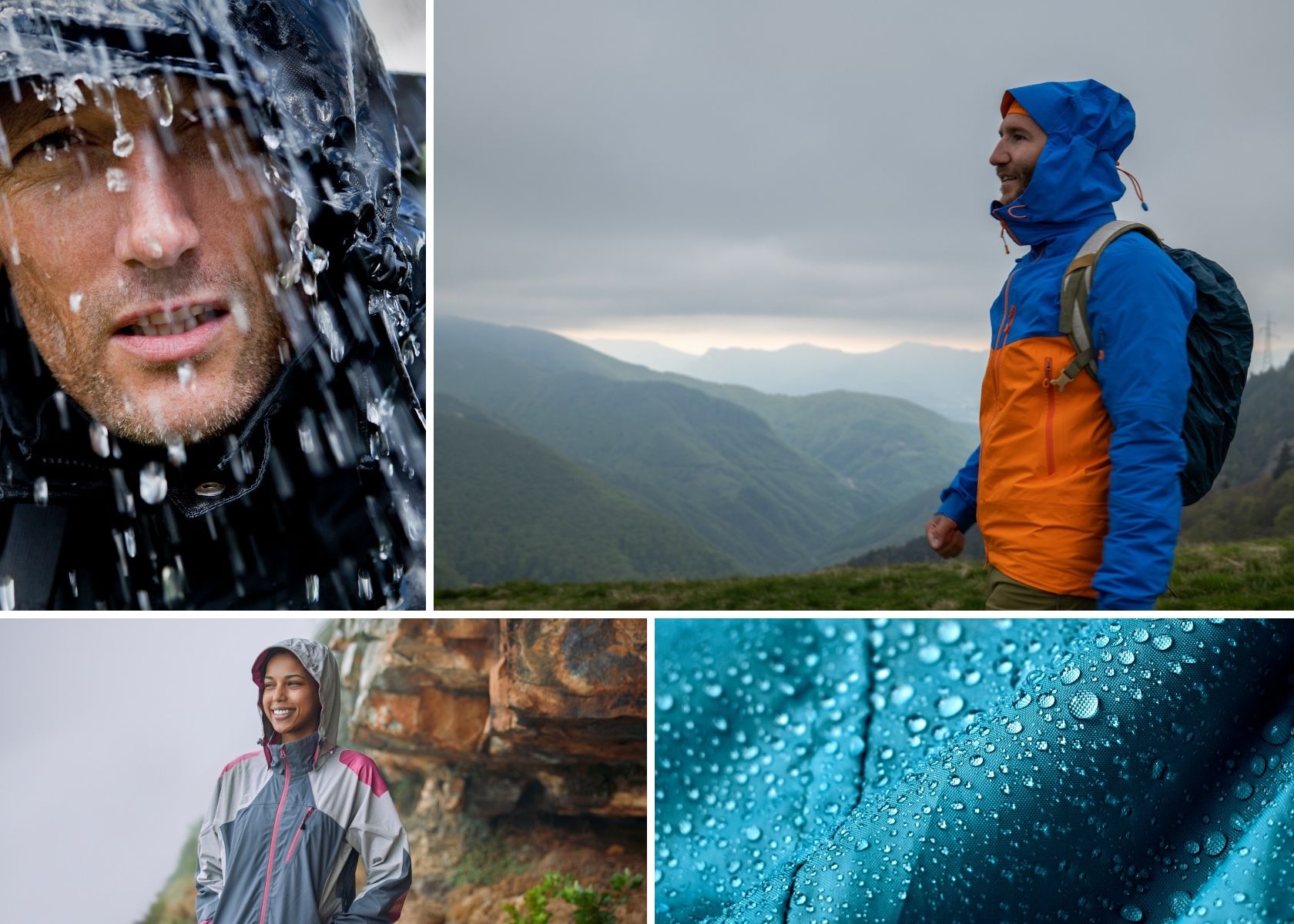WATERPROOF JACKET BUYING GUIDE
A great waterproof jacket is essential for the slopes, no question. But finding the right one for you isn't always so simple. Finding a jacket with the right features, waterproofness and breathability for you will ensure many long days of shredding in comfort.

The Right Jacket
Different waterproof jackets are designed for different activities. Jackets designed to be lightweight and highly breathable, for example, are great for trail running or cycling, while a more hardwearing, stiffer jacket will be needed for dedicated mountaineers.
The first thing to do when you're choosing a waterproof jacket is to decide what features matter to you. Does it need to be lightweight, or would you prefer a heavier jacket with better weather protection? How intense is your activity, so how breathable does the jacket need to be? Does it need to be extra-durable?
Waterproof Ratings
A jacket's waterproofness is expressed as a rating called a hydrostatic head. Generally, a minimum of 5,000mm is good for both skiing and snowboarding in cold but clear conditions, especially if you'll be taking regular breaks. 5,000mm-10,000mm is ideal for those who spend long days out on the mountain in all weather conditions, while 10,000mm-20,000mm is best for those in wetter climates, or backcountry skiers and boarders.
| Rating (mm) | Protection Level | Typical Use |
|---|---|---|
| 1,500-5,000 | Light rain | Everyday wear, light hiking |
| 5,000-10,000 | Moderate rain/snow | Hillwalking, city, travel |
| 10,000-20,000+ | Heavy rain/blizzards | Mountaineering, snowsports, trekking |
Does it have to be GORE-TEX®?
GORE-TEX® is the most well-known waterproof membrane thanks to its durability and breathability - but it's not the only option out there. Some brands, including Rab and The North Face, develop alternative waterproof membranes, and others might use GORE-TEX® in some products and not others. Each one will offer slightly different benefits which will depend on your activity, so it's all about finding the right one for you.
Construction
Most waterproof jackets use a 2-layer, 2.5-layer or 3-layer construction.
All three construction types have a durable water repellent (DWR) coated outer fabric, or face fabric, which helps to protect the rest of the jacket against moisture. The second layer is the waterproof part: the membrane which gives the jacket its water repellent and breathable properties.
The final layer is the one which differentiates the constructions. 2.5-layer jackets have a thin polyurethane (PU) layer painted onto the inside of the waterproof membrane, to protect this layer from being clogged up with sweat and oils. 3-layer jackets have a thicker PU layer on the inside, making them the most durable choice, but are usually not as breathable or lightweight as 2.5-layer jackets.
Types of Waterproof Jacket
1. Hardshells
- Built for maximum protection with minimum weight.
- Use technical membranes; ideal for alpine, winter, and multi-day trekking.
- Usually no insulation—meant to be layered.
2. Insulated Waterproof Jackets
- Combine waterproof shells with built-in insulation (synthetic or down).
- Best for stationary or cold, snowy pursuits (like winter resort skiing).
3. Softshell Hybrids
- Blend some water protection with stretch and breathability for high-movement sports.
- Best used in dry, cold, or light snow, or as a midlayer under a true waterproof shell.
4. Packable / Lightweight Jackets
- Ultralight, minimalist, designed to stash in a pack for emergencies.
- Often have lower durability and simpler features, but life-savers when weight counts.
Key Features
Hood
Think about the fit of your hood: does it cover your whole head and allow freedom of movement? Does it need to be roomy enough for a helmet? Does the peak protect your eyes?
Pockets
The number of pockets you need will, again, depend on what you'll be doing. Hand pockets are standard for most jackets, but if you'll be wearing it for climbing you'll need to make sure the pockets sit above your harness for accessibility. Large chest or inside pockets are great to have for storing maps and compasses.
3-in-1 Jackets
A 3-in-1 jacket combine a waterproof jacket with a removable inner layer, usually a fleece or insulated mid-layer. They can be worn together or separated into their different parts and worn individually.
Pull-Cord and Velcro
Your waterproof needs to seal around your head, hands and waist to effectively keep your dry. Look for Velcro hood and cuff closings and a good-quality draw cord when choosing a jacket.
Taped Seams
A jacket won't be waterproof without taped seams: heat seals which prevent water coming in through the stitching. These are particularly important to have if you'll be using your jacket in prolonged heavy rain.
Chin Guard
A chin guard is a soft piece of fabric on the inside of the jacket to protect your face from rubbing or catching the zip or waterproof fabric. This goes a long way towards preventing discomfort, especially in the rain, so is a great little feature to look out for.

Expert Tips for Buying a Waterproof Jacket
- Prioritise your activity. A jacket for backcountry skiing needs different features (like robust face fabric and snow skirt) than one for city walking.
- Check for future-proofing: Look for replaceable zippers and repairable membranes, as well as eco-friendly or recycled face fabrics when possible.
Waterproof Jacket FAQs
Waterproof jackets will not let water penetrate and use membranes with sealed seams. Water-repellent jackets have a DWR coating but no true membrane, so they protect in brief or light showers only.
GORE-TEX remains the gold-standard, but many modern alternatives rival or surpass it in breathability or sustainability. Prioritise the membrane that matches your activity and climate—GORE-TEX Pro for maximum protection, or eVent for high-exertion sports.
Yes, but use a technical wash like Nikwax Tech Wash, and never standard detergent, which can strip water-repellency. Regular cleaning revives both breathability and water repellency.
Look for:
- Helmet-compatible hoods
- Powder skirts
- Lift pass / sleeve pockets
- Extra durability in high-wear areas
- Seam taping and high waterproof/breathability ratings (15,000mm+/10,000g+).
This usually means the DWR has worn off. Reapply a spray-on or wash-in DWR treatment after cleaning to regain performance. Membrane will still keep you dry, but “wetting out” reduces breathability.
Women’s jackets often include tailored insulation, shaping, and adjusted sleeve/body lengths. Men’s designs may have broader shoulders and longer hem. Pick what feels best and performs for your needs.
UK winters call for full waterproofing, adjustability, and versatility. In the Alps, prioritise snow-specific features, helmet compatibility, and sometimes insulation, depending on altitude and average temperature.
Related Articles

Let us know you agree to cookies
We use marketing, analytical and functional cookies as well as similar technologies to give you the best experience. Third parties, including social media platforms, often place tracking cookies on our site to show you personalised adverts outside of our website.
We store your cookie preferences for two years and you can edit your preferences via ‘manage cookies’ or through the cookie policy at the bottom of every page. For more information, please see our cookie policy.



